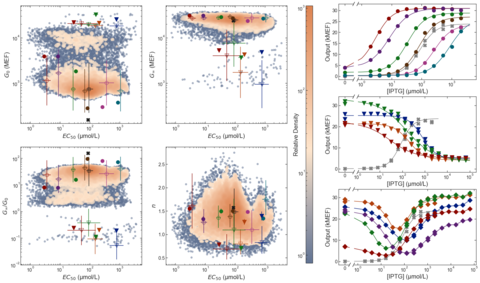Large-Scale Genotype-Phenotype Landscape Measurements for Precision Engineering of Living Measurement Systems
Summary
All living things measure their environment, make decisions, and respond. Systematic re-engineering of these living measurement and control systems has the potential to impact every sector of the world’s economy including manufacturing, medicine, agriculture, and energy. However, existing approaches for engineering new biological sense and response systems lack the precision and predictability required for many of the proposed next generation of biotechnology products, such as engineered living therapeutics or structured biomaterials synthesis. To overcome these limitations, the Cellular Engineering Group is developing a generalizable workflow for the engineering of living measurement systems with precisely defined characteristics.
Description
Synthetic biology promises an array of world-changing innovations including living therapeutics that fight infections and cancer or even regrow whole organs in situ; cellular factories that weave materials with nanoscale features; and synthetic ecosystems that produce fertilizer and pesticides on-demand. With this project, we are developing a scalable and generalizable workflow for the engineering of the key enabling component for all of these proposed innovations: living cells that measure and respond to their environment in a precisely defined way.
To accomplish the project goals, we are leveraging advances in DNA sequencing technologies and laboratory automation to measure the genotype-phenotype relationships for thousands or millions of cellular sensors in a single measurement. We can then identify the DNA sequence for the sensor that has the precise dose-response curve required for an engineering project and have that DNA sequence synthesized for use. The figure below shows a result for the measurement of 60,000 sensors engineered in the bacterium E. coli. The left four panels show 2D density plots of the wide range of different sensor functions that were measured. The right three panels show the results for a set of sensors engineered to have precisely defined mid-points in their dose-response (EC50), a set of sensors engineered to have an inverted sensor dose-response relative to the wild-type sensor, and a set of sensors discovered to have a novel band-stop dose-response.
RELATED PUBLICATIONS AND PRESENTATIONS
- The genotype-phenotype landscape of an allosteric protein
- Interpretable modeling of genotype-phenotype landscapes with state-of-the-art predictive power
- Presentation at EBRC Annual Meeting April 2021: Precision Engineering of Biomolecular Function with Massively Multiplexed Genotype-Phenotype Measurements and Machine Learning
- Poster at SEED June 2021: Precision Engineering of Biomolecular Function
- Poster at SEED June 2021: Interpretable Modeling of Genotype-Phenotype Landscapes with State-of-the-Art Predictive Power


